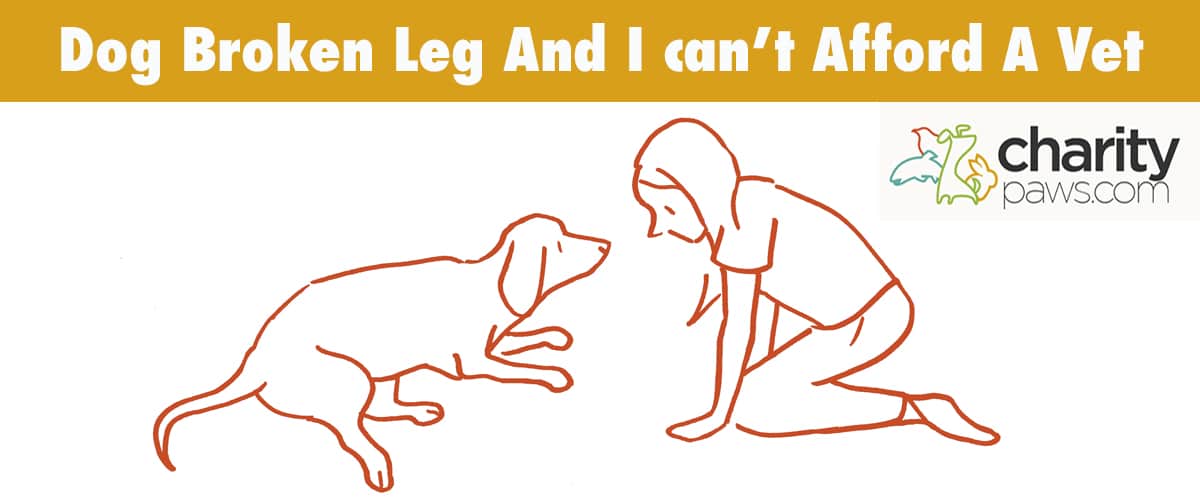No matter how much we want to provide for our pets and offer them the care they need, it’s not always that simple.
Many dog owners are faced with the challenge of not being able to afford vet care each year, especially when their pups experience a sudden injury or medical emergency.
So what happens if your dog suddenly breaks their leg and you cannot afford veterinary care?
Let’s discuss some of the options available to you.

How Do Dogs Break Their Leg?
The potential causes of a bone fracture can be unexpected for some dog owners.
Though many of us are aware that bones can break with sudden trauma, there are other possibilities that you should be aware of as well.
Some of the most common causes of broken legs, as well as risk factors, in dogs include:
- Rough play
- Falling or jumping from a high location
- Falling off furniture
- Hit by a vehicle
- Trauma during puppyhood, as their bones are not as strong
- Improper nutrition causing weak bones
- Prolonged strenuous exercise
- Sports
- Bone cancer
- Breed, as toy breeds are more prone to fractures
If your dog falls into any of the above categories, and they are suddenly limping and experiencing significant pain, a bone fracture should be ruled out.
Signs Of A Broken Leg In Dogs
Not only is it important to be aware of the activities that can lead to a broken bone in dogs, you should also be aware of the potential signs of a broken leg in your furry friend.
Though these symptoms can be a result of other soft tissue injuries and trauma to the area, there are a few signs that dogs with broken bones often display.
Some of the most common symptoms if a broken leg in dogs include:
- Inability to put weight on the limb
- Holding the limb up
- Crying out when they put weight on the limb
- Unwillingness to walk
- Swelling of the limb
- Limb falling into an abnormal position
- Bruising of the limb
- Pain when the limb is touched
- Grinding of the bones
If your dog is experiencing any of the above symptoms, it is very possible that they sustained a serious injury to their leg.
What To Do If Your Dog Has A Broken Leg
If you think your dog may have broken their leg, it’s important to reach out to your primary veterinarian.
Though you may be worried about the potential costs that come along with this, many veterinarians will still perform a physical exam on your dog if they have an established relationship with your pet.
Though the only way to definitely diagnose your dog with a broken limb is with x-rays, a physical exam can still provide your vet with some answers.
If your vet is able to manipulate their limb in a way that does not align with a fracture, this can tell them that your dog may be able to heal with conservative at home care.
If your vet does believe your dog has a broken leg and you cannot afford to treat them at that moment, they may then discuss payment plan options, outside resources, or conservative treatment options.
How Much Does It Cost To Treat A Broken Leg In Dogs?
The standard cost of treating a broken leg in dogs will vary based on the severity of their fracture.
For example, while some fractures can be healed through 8-12 weeks of splinting, other breaks will require surgical repair.
This is what causes the prices to vary from case to case, with standard costs ranging from $500 to $3,000.
Before panicking about the potential fees that come along with your dog’s treatment, you should first determine how severe their injury is.
If you are able to find a veterinarian that will work with you in performing x-rays, this is the best way to know what’s in store.
If you cannot find a vet that offers treatment plans, you can then explore options like Care Credit or Scratch Pay, as well as local rescues or charities that assist owners with hefty veterinary bills.
Dog Has A Broken Leg But I Can’t Afford A Vet, What Can I Do?
Once you know that your dog does in fact have a broken limb, it is time to explore the potential treatment option available to your pup.
If at this point you know that you do not have the funds to offer them veterinary treatment, there are a list of potential options available to you.
To help you better find a helpful resource for your dog, let’s list a few of the options for assistance below.
Payment Plans At Your Vet’s Office
The first option you should always explore is asking your veterinarian if there are any payment plan options at their office.
Many vets can offer some leniency when you have an established relationship with them, or they may even have a fund set aside for these situations.
Though we know it’s hard to ask for help, it is always worth asking.
Keep in mind that while we all know how stressful of a situation this is, it is important to approach these issues with kindness.
Working in an emergency animal hospital for almost 6 years, I unfortunately encountered many clients that could not afford to treat their pet.
In virtually all cases where the client was kind and understanding of the limitations we had as a business, we were always able to help with payment in some form.
It is when clients resorted to yelling or name calling when the animals would not receive help, as this reaction made it challenging for everyone to do their job.
Though I know how stressful of a time this is, I urge you to remain as calm as possible when discussing payment assistance with your veterinary team.
This will ultimately help your beloved companion.
Reaching Out To Different Vet Clinics & Shelters
If your veterinarian cannot offer payment assistance, or you do not have a primary veterinarian, you can begin to call any clinics or shelters in your area and ask for their guidance.
You can ask them if they offer any payment assistance and if not, do they know of any resources in your area that you can explore.
Veterinary Credit Lines
Due to the many clients that have struggled to cover their pet’s veterinary emergencies over the years, there are now credit lines available to pet owners.
Companies like Care Credit and Scratch Pay allow pet owners to apply for their credit line when they need it, offering immediate access to those funds if they are approved.
If you do get approved for the credit line, you pay it back monthly like a standard credit card.
Interest charges vary based on the option you are approved for, so be sure to research these options before you accept them.
Local Dog Rescues & Charities
Thankfully, there are many dog rescues and charities that were designed to help animals and owners in need.
These organizations have donated funds that allow them to help animals in desperate situations, and some even offer assistance to owners that are facing financial hardships.
These rescues can be breed specific, animal specific, and even situation specific.
Keep in mind that while many of these organizations can step in and help, some will require you to surrender your animal to their care.
We understand that not everyone will be okay with this, but it is an option if you cannot find funds elsewhere.
Social Media
Social media can offer assistance in many ways if you are struggling to fund your dog’s vet treatment.
First, you can join local animal rescue and pet lovers Facebook groups and share your current situation.
Some group members may be willing to donate to your pet’s treatment, while others may have links to organizations that can offer assistance.
Next, you can also create a GoFundMe or other campaign that allows people to donate to your dog’s care, whether it is from family members or animal lovers on the internet.
GiveSendGo is a newer competitor to GoFundMe that allows for people to raise money for pet care costs.
You would be surprised at who may be able to help.
I have raised funds for a foster kitten by joining a cat rescue Facebook group and sharing the kitten’s story, so it can be done.
Treatment For Broken Leg In Dogs
As we mentioned above, the standard treatment for a broken leg in dogs will vary based on the severity of the break.
Some simple fractures may only require a splint (cast) and strict exercise restrictions for 8-12 weeks, while others will require orthopedic surgery.
Your dog’s x-rays should make the extent of their injury clear and allow your vet to explain the treatment options available to your dog.
Another option to consider when funds are low is the possibility of leg amputation.
While I know it may seem daunting when a broken bone is technically fixable, sometimes an owner’s funds just do not allow it.
If it is an ultimatum of euthanasia due to a lack of funds versus amputating the leg, then losing the leg is the best option.
If this is the route you must explore, just know that many dogs go on to live perfectly happy lives with three legs.
Dog Broken Leg Recovery Time
Whether your dog requires a splint or an orthopedic surgery, you can typically expect a minimum of 10-12 weeks of strict rest.
Their recovery relies on their ability to rest the limb properly, as any stress on the leg can damage any healing progress that is made along the way.
Your vet will offer you specific instructions on their recovery, but you can always expect strict exercise restrictions no matter what.
If your dog has their leg amputated, they are typically recovered and ready to get back to normal life within 2-3 weeks.

Final Thoughts On A Dog With A Broken Leg
We know just how hard it is to be in this position, so we hope you can find the resources you need to help your furry friend.
There are now many options on how you can pay for your vet bill, so finding help to pay for your dog’s broken leg is as easy as searching for those options and making some phone calls.
Be sure to ask your vet about any payment assistance options they can offer, as well as whether or not they have links to organizations that can help.

